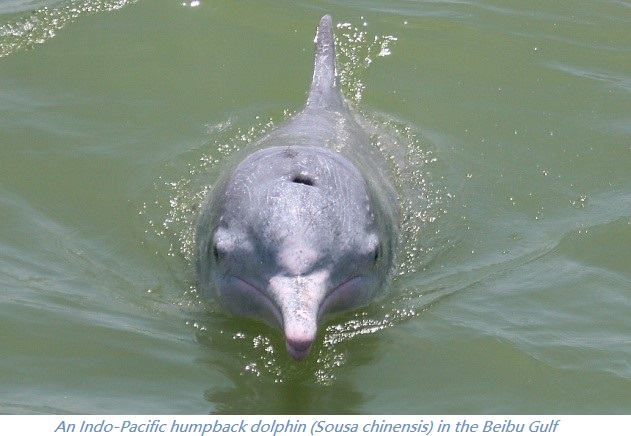Humpback dolphins in South China Sea gulf
synchronized with seasonal and tidal, suggesting conservation solutions
Researchers at Nanjing Normal University in China have concluded that
Indo-Pacific humpback dolphins (Sousa chinensis) in the Beibu Gulf,
China, travel between deep, gulf water and shallow, estuary zones based
on season and tide. The scientists believe that they do this to follow
prey with the same migration pattern.
The Beibu Gulf, located in the northwestern South China Sea, is
supplied by water from two rivers, and the area leading into the
saltwater gulf is an estuary. During the wet season (May-September),
the estuary becomes less shallow and more accessible to the dolphins.
It has been reported that most fish species, including those humpback
dolphins prey on, follow the same pattern, which lead authors of the
report to conclude that the dolphins migrate to follow a food source.
During the wet season, the estuary is also a good habitat for the
humpback dolphins. It accommodates their sensitivity to water salinity
and the deeper water that comes with the wet season decreases their
risk of stranding. Fury and Harrison (2011) reported that bottlenose
dolphins in an Australian estuary have the same pattern.
This study hopes to influence conservation strategies for Indo-Pacific
humpback dolphins. “The management and protection of the marine nature
reserve has always been difficult. Due to its open character,
anthropogenic activities cannot be restricted like in land nature
reserves,” said Dr. Bingyao Chen, one of the study’s authors. “This
paper determines the seasonal and tidal core area of distribution of
this species, which means we can better protect them
seasonally.”
However, human influence remains a problem for conservation. “Some
anthropogenic activities, especially fishing, are the mainstays of the
local economy. It is impossible to forbidden all fishing activities on
the reserve. Therefore, we must work to transform the jobs of local
fishermen to promote a win-win situation between dolphins and
fishermen.”
Read the full article, published by Zoological
Studies, here:
http://zoolstud.sinica.edu.tw/Journals/57/57-01.html
Follow Zoological Studies on
Twitter @ZooStudies and Facebook
References:
Fury CA, Harrison PL. 2011. Seasonal variation and tidal influences on
estuarine use by bottlenose dolphins (Tursiops
aduncus). Estuar Coast Shelf S
93(4):389-395.
Media contact: Noah Last: lastn@gate.sinica.edu.tw
